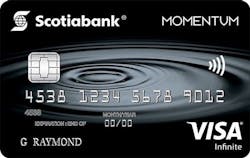What is a Balance Transfer Credit Card?
Balance transfer credit cards allow you to transfer outstanding credit card debt to them.
You can also merge several credit card balances onto a single balance transfer credit card. This can make it easier to manage your debt and payments.
Balance transfer credit cards often have an initial low interest rate, as low as 0%, for a predetermined period. Once the low interest period has ended, the interest rate will increase.
This promotional period is often between six and ten months. It’s helpful to try and pay off as much of your debt as you can during this low-interest period.
Keep in mind that you still have to make minimum payments on a balance transfer credit card. Failing to pay your minimum payments will result in losing your low interest rate and any other introductory bonuses. As well, missing minimum payments can hurt your credit score.
A minimum payment is typically between 1% and 3% of your balance. If this percentage is less than $10 then your minimum payment will be $10. Your balance includes any accrued interest and fees.
What Determines the Best Balance Transfer Credit Cards
There are many things to consider when looking for the best balance transfer credit card. Above all, be sure to choose a credit card that is best suited for you.
When comparing the best balance transfer credit cards in Canada, consider:
- Balance Transfer Interest Rate
- Balance Transfer Fee
- Promotional Period
- Terms and Conditions
- Eligibility
- Annual Fee
- Reviews
Balance Transfer Interest Rate
To save as much as you can on interest, try to find a balance transfer credit card with the lowest interest rate.
Examples of common balance transfer interest rates in Canada include:
- 0.00%
- 0.97%
- 0.99%
- 1.95%
- 1.99%
- 3.99%
Typically, these rates are offered for 6 or 9 months.
In addition to the promotional interest rate, consider the regular interest rate. This is important because eventually, when the grace period is over, you’ll have to pay the regular interest rate. If you still have money to pay off once the promotional period ends, a low interest rate will be helpful.
Also, keep in mind that new purchases are subject to the regular interest rate. Only the pre-existing balance falls under the promotional interest rate.
For example, if you make a new purchase with your balance transfer credit card, the interest rate might be 19.99%, rather than the promotional 3.99%. Therefore, it’s best to avoid making new purchases on a balance transfer credit card, if you can. Instead, focus on paying off old debt as quickly as possible.
It is also important to note that payments will always go towards the transferred balance first. New purchases will only be paid off once the entire transferred balance is paid off.
Balance Transfer Fee
It’s common for balance transfer credit cards to charge an initial transfer fee. Transferring a credit card balance usually results in one of the following fees:
- A standard fee
- A fee equal to a percentage of the balance you’re transferring
In Canada, balance transfer fees typically range from 0% to 3%.
Paying a transfer fee will likely outweigh the cost of continuing to pay a high interest rate on your other credit card.
When choosing the best transfer credit card for you, consider which card offers the lowest transfer fee.
Promotional Period
Before settling on a balance transfer credit card, take note of the promotional period.
Look for a card with the longest promotional period. Doing so will give you as much time as possible to pay off your debt while receiving a low interest rate.
Terms and Conditions
Ensure you read the terms and conditions of each balance transfer credit card that you’re considering.
The terms and conditions will include details about:
- Fees
- APR (annual percentage rate)
- Fines
- Balance transfer limits, and more
The best balance transfer credit card will have terms and conditions that meet your needs.
Eligibility
The best balance transfer credit cards in Canada may be accompanied by certain eligibility requirements. Take these into consideration before applying. This will ensure you can qualify and are not wasting your time applying.
Eligibility requirements may include:
- Credit score
- Annual income, and more
Annual Fee
To have more money to put towards your principal, find a balance transfer credit card with a low, or no, annual fee.
It’s possible to find a balance transfer credit card that won't cost you an arm and a leg in annual fees. After all, these credit cards are meant to help you pay off debt, not accumulate more.
Reviews
When deciding on the best balance transfer credit card, look for reliable and unbiased reviews.
Using online reviews like this one can help you more easily compare cards. It will also save you time on research.
Best of all, reading reviews can help you narrow down your search and find a card that’s right for you.
How Do Balance Transfers Work?
Balance transfers are pretty straightforward. Here’s how they work:
- Complete the application for the balance transfer credit card of your choice.
undefined - Within 2 to 4 weeks after you’re approved, the balance transfer credit card issuer will contact the creditors you owe and pay them the amount you disclosed in your application.
undefined - Make any balance transfer within the time frame given by the credit card issuer.
- Ensure you make minimum payments on your new card. Failing to do so might lead to losing your low interest rate.
undefined - Use the promotional period to pay off as much debt as possible. During this time, your interest rate will be low or even zero.
- Avoid new purchases.
Here are a few things to keep in mind when going through the balance transfer process:
- There may be a credit limit that you cannot exceed.
- There may be a transfer limit based on a percentage of the credit limit.
- If you cannot fit all of your unpaid credit card debt onto one balance transfer credit card, transfer the balances associated with the highest interest rates.
Example of a Balance Transfer Credit Card
Let’s look at an example to see how a balance transfer credit card can be a useful tool for paying off credit card debt.
In this example, we’ll assume you have a balance of $5,000 on a credit card with a 19.99% APR. Each month you pay $500 towards your balance.
Here’s what you can expect when trying to pay off a regular, high-interest credit card:
- Balance: $5,000
- Interest rate: 19.99%
- Monthly payment: $500
- Interest owed: $515
- Months to pay off balance: 12
Now, here’s what the same scenario looks like with a balance transfer credit card:
- Balance: $5,000
- Interest rate: 0% for 6 months
- Monthly payment: $500
- Interest owed: $0
- 1% balance transfer fee: $50
- Months to pay off balance: 10
Please Note: These calculations are based on credit cards with $0 annual fees and no additional charges made to your credit card.
Using this example, you can see that a balance transfer credit card will save you $465 ($515 - $50). This strategy will also help you pay off your debt in 10 months, rather than 12.
FAQs

Emma is responsible for all content on Creditcards360.ca. She has a college degree in economics and a keen interest in personal finance. Get in touch with her by email.

